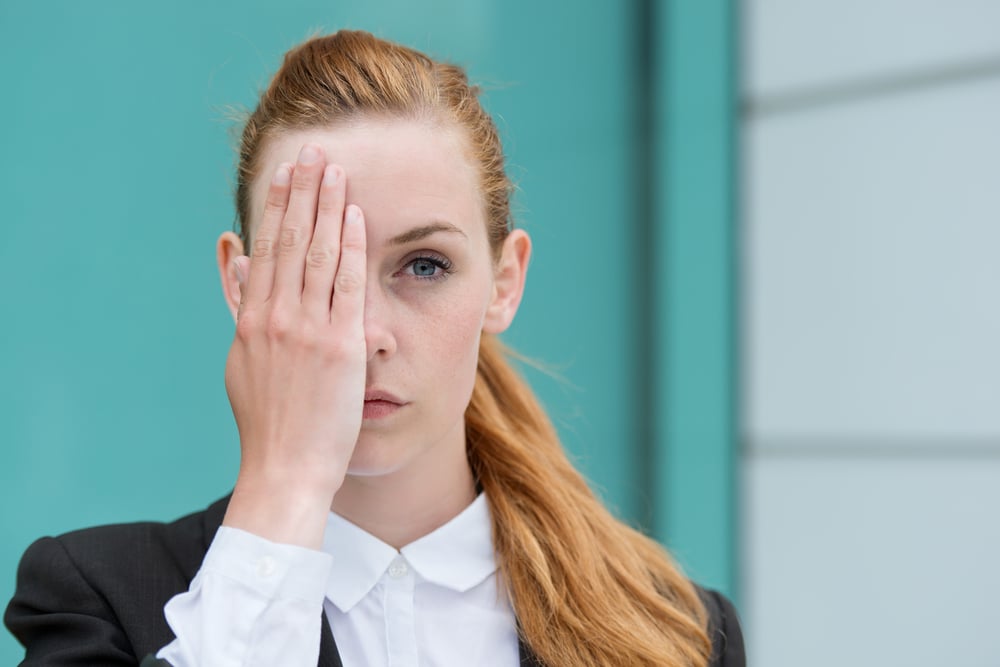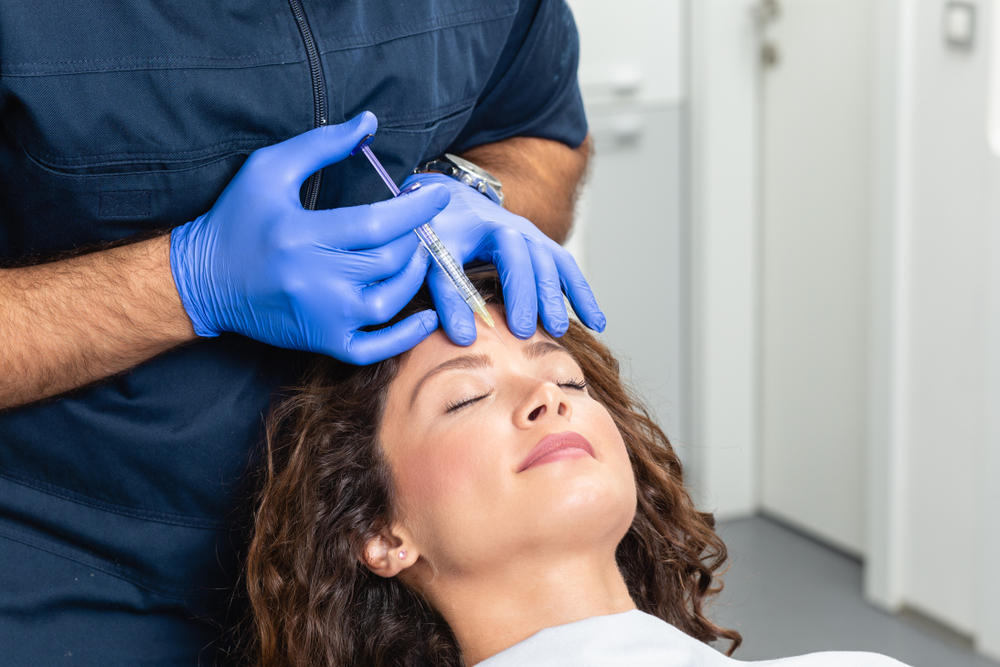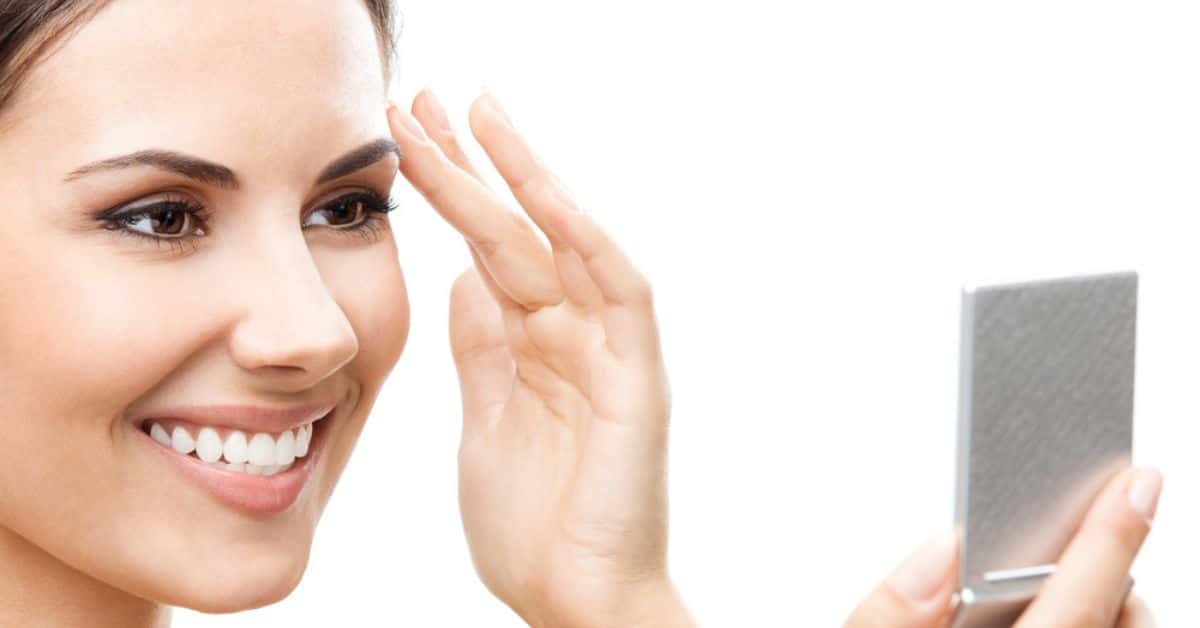- A droopy eyelid is a rare side-effect of Botox injections.
- Eyelid drooping, or eyelid ptosis as doctors call it, will typically self-correct in a matter of weeks.
- There are treatments available to minimize eyelid “droop” when it happens.
Botox is seen by many as a modern miracle. With a quick injection routine every three to four months, you can stave off eye and forehead wrinkles for years. The procedure itself is simple and fast, while the effects are nearly instantaneous.
It’s no wonder that Botox is one of the most popular cosmetic procedures in top clinics around the world.
However, Botox isn’t without its potential problems and side-effects. One rare and unfortunate side-effect is a drooping eyelid.
A drooping, hooded eyelid causes the face to look asymmetrical. Ptosis can be quite unsettling, but thankfully the condition is not permanent and fades over time.
Additionally, the risk of this problem can be minimized by following certain injection guidelines during the procedure. However, even if these guidelines are followed, eyelid ptosis may still occur in some patients.
If you’re here because you’re experiencing the unpleasant side effects of a “botched” Botox injection, keep reading: we asked four board-certified cosmetic doctors for their advice.

Bid a big bye to your Droopy eyelids
Since droopy eyelids or eyelid ptosis can restrict your vision and affect your appearance, here are a curated list of products that can help you
Cetaphil Hydrating Eye Gel Cream
CETAPHIL HYDRATING EYE GEL-CREAM hydrates the skin around your eyes and is applicable for all types of skin. Get your hydration on with hyaluronic acid, which lasts for 24 hours. This eye gel cream is appropriate for contact lens wearers and sensitive eyes .
Eye Control by Aminogenesis
Eye control is the serum that helps to tighten, lift and firm the droopy eyelids. This eye cream also reduces the crow feet and fine lines around the eyes. Additionally, it helps reduce the appearance of puffy eye bags and dark circles. Use this product on a daily basis for better results.
Dermactin-Ts Upper Eyelid Cream
Dermactin-Ts Upper Eyelid Cream is especially recommended for sensitive skin. This cream helps the skin around the eyes to be firm and with a good tone. This cream is a one-stop solution for the sagging skin that lifts the skin perfectly and permanently. Use Dermactin-Ts Upper Eyelid Cream on a daily basis for better results.
Revitalift Anti-Wrinkle and Firming Eye Cream
Revitalift Anti-Wrinkle and Firming eye cream will fight for your firm skin, reduce dark circles and wrinkles in 4 weeks. This eye cream is fragrance-free and non-greasy tested for safety. This cream is also recommendable for lens wearers. This cream fights against the signs of aging.
Ultra-Lift Anti-Wrinkle Eye Cream
Ultra-lift anti-wrinkle eye cream hydrates the eye and reduces the wrinkles and fine lines around your eyes. Improve skin elasticity, with a refreshing and bright tone.
What causes droopy eyelids after Botox?
The botulinum toxin contained in Botox injections works its magic by causing intentional muscular paralysis in the face. This intentional paralysis prevents the muscles that cause crow’s feet, smile lines, and forehead wrinkles from contracting.
Unfortunately, doctors don’t have 100% control over where that toxin goes once it’s been injected into your skin. On rare occasions, it will migrate through the dermis to a muscle above the eye called the levator palpebrae.
This muscle controls the raising and lowering of your eyelid. You can think of the levator palpebrae muscle like a garage-door opener for each of your eyes: when the muscle contracts back and away from the front of your face, your upper eyelids are pulled open.
Unfortunately, if just a little bit of that botulinum toxin comes in contact with one of your levator palpebrae muscles, you’re going to find it impossible to open your eye all the way. This effect is the dreaded eyelid droop.
South Florida dermatologist Dr. Todd Minars explains: “The cause of eyelid ptosis is either too much Botox or placing it too close to the eyelid, causing the Botox to migrate into the muscle that gives the eyelid lift and tone.”
There’s an art to applying Botox injections. Experienced doctors have an excellent understanding of facial musculature and make educated decisions on where to inject. By properly choosing specific locations and depths, they can greatly reduce the potential for subsurface migration of the botulinum toxin.
Board-certified dermatologist Dr. Tsippora Shainhouse, a clinical instructor at the University of Southern California, stresses the importance of assessing a patient’s facial muscle movements prior to Botox treatments in order to accurately map injection points.
“When ptosis occurs after Botox injections, it is often because the neurotoxin was injected too low in the frontalis [forehead] muscle, which causes the forehead to ‘relax’ downwards, thus pushing down the upper eyelid,” says Shainhouse.
The Complete Botox Procedure: Before And After
Following are the things you can expect before and after the Botox injections.
Before the procedure:
90% of the people do not feel any discomfort before or during this treatment session. To ensure that, your doctor may numb your skin beforehand. Doctors use any one of the methods, like topical anesthesia, ice, or vibration anesthesia, for this procedure.
During the procedure:
Doctors generally use a thin needle to inject the botulinum toxin into the skin or muscles where you need improvement. The number of injections necessary for you depends on various factors.
They are
Gender:
- Here, gender plays a vital role. Generally, men need more Botox units as they have larger facial muscles than women.
- Stronger and rigid muscles need more Botox units than weaker and thinner ones.
- Generally, men need two to three times more Botox units than women.
Muscle activities:
- How frequently we use muscle also has a role here.
- Some areas we use more often may need more units of Botox to achieve the desired results.
- How a person uses facial muscles and which muscles he uses often depend on him.
- So, finding how many Botox units a person needs depends on an individual basis.
Metabolism:
- The next factor is metabolism, the breakdown of food and its conversion into energy.
- Individual consideration plays a role here since each person’s metabolism is unique.
- Generally, Botox injections will be effective in your body for three to four months.
- But people with a higher metabolism may need more Botox or more frequent injections based on how their body processes this Botox.
- A heavy exercise routine increases your metabolism, which causes the Botox effects to wear away faster.
Previous Botox history:
- The effects of Botox eventually wear away, even though you have been using Botox for a long time.
- Usually, Botox results stay an average of four months, but someone who gets botox regularly for years can see prolonged results lasting up to six months.
- If you are a beginner, start with as few units as possible and then increase the units gently if necessary to achieve the desired results.
Treatment goals:
- First, understand what you need by asking some questions to yourself.
- Some may like to smooth wrinkles and retain some muscle movement. But some want to eliminate the entire wrinkles without having any muscle movement.
- Those requirements determine how many units of Botox a person needs to get the desired results.
- Fewer Botox units are necessary if you want to retain some partial muscle movement.
- Sometimes, more Botox units may be necessary in the case of deep wrinkles as opposed to fine lines.
Budget:
- First, decide your budget, which can be extremely helpful in determining the treatment and how many units of botox you can afford.
- Starting with an area requiring fewer botox units is better if you have a low budget. Then go to larger sizes as you can afford them.
- Wait until you can afford the cost of a complete treatment rather than ending with a partial cure.
- Otherwise, you may need treatments more often, spending more money.
Read the following topics and points to know more about what to do after Botox.
How Common Is Ptosis After Botox?
Droopy eyelid or ptosis is the most common adverse reaction to Botox injections. It is rare but a small range, around 5% of people who get Botox, may have this issue with eyelids.
Some people fail to find this ptosis in the initial days. Ptosis in the eyelids and brow areas generally appears within days to a week after getting the botox injection.
Relax! It is not a threat. Droopy eyelids are not permanent. You may have droopy eyelids for a maximum time limit of 2 to 3 weeks after the botox injection. It is essential to consult a skilled doctor to avoid this in the first place.
Other Side Effects Of Botox
Even though Botox injections are relatively safe, you can expect some side effects and complications when an inexperienced doctor does it.
They are
- Swelling, mild or severe pain, or bruising at the injection site or nearby place.
- Eye dryness or tearing
- Cockeyed eyebrows
- Headache or flu-like symptoms
- Crooked smile
- Drooling – excess saliva flows out of your mouth involuntarily.
Get your doctor’s help if you notice the following side effects after Botox.
- Severe eye issues such as sudden vision loss
- Blurred vision, tunnel vision, eye pain or swelling, or seeing halos around lights,
- Severe heart complications include fast, irregular, fast-beating, fluttering, or pounding heart.
- Shortness of breath
- Sudden dizziness.
- Confusion state
- Slurred speech
- Sudden weakness in the arm or leg, trouble walking, and loss of coordination.
What can be done to avoid eyelid ptosis after Botox?
The first and best piece of advice: always visit a board-certified dermatologist or plastic surgeon who has experience with Botox and who understands facial musculature.
Additionally, don’t settle for generic products. Before your procedure, ask your doctor to confirm that the botulinum injections that they use are from a well-known, “brand name” manufacturer.
Botox is manufactured only by Allergan. Other quality products are Dysport, which is manufactured by Medicis, and Xeomin, which is manufactured by Merz. All three of these products have undergone extensive testing and may have more predictable results than no-name, generic products.
Also remember that even if the injections are done with name-brand solutions, in the correct locations, and at just the right depths within the dermis, there’s still a small chance of getting eyelid ptosis. That said, it’s not a permanent condition, fortunately, and it can be treated.
How long will a droopy eyelid last after Botox?
Here’s the good news: most droopy eyelids go away on their own after four to six weeks. The bad news is that you’ll be walking around with one of your eyes half-shut all of that time, and, in rare cases, a droopy eyelid can last even longer than six weeks.
As Beverly Hills plastic surgeon Dr. Leslie Stevens explains, “Generally the unwanted effect lasts for less time than the intended one because a lower dose reaches that muscle. If not, it could last for up to three to four months — the same time that Botox lasts.”
The amount of time your ptosis lasts therefore depends on how serious the migration of the botulinum toxin was in the first place, and how much of it actually came in contact with your levator palpebrae muscles.
What can be done if the Botox migrated?
If you’re here because the dreaded eyelid droop has happened to you after a Botox injection, there are some things you can do.
First off, it is worth repeating that eyelid ptosis caused by Botox injections is a rare and temporary condition. Although it can be embarrassing in professional and social situations, it’s not life threatening or permanent.
Talk to your doctor about getting Iopidine (apraclonidine) eyedrops as a remedy. Iopidine drops reduce the effects of ptosis by causing another muscle in your eye — the Muller’s muscle, which is located next to the levator palpebrae — to seize up and contract. When this happens the eyelid is temporarily forced open — correcting the droop.
Similarly, some doctors also recommend additional Botox injections to stimulate different muscles to fix the ptosis. “There’s no ‘antidote’ for bad Botox,’ says Shainhouse. “It has to wear off. However, it’s possible to add Botox to other muscles that may have an opposing effect.”
Shainhouse recommends adding a few units high into the forehead, which may reduce the heaviness of the brow, and a few units added under the tail of the eyebrow that “may open the eye a little wider to reduce the ptosis by one or two millimeters.”
It’s also worth noting that some patients may think that they have eyelid ptosis when in fact it’s the forehead that is sagging as a result of the injections.
Danville, CA dermatologist Dr. Jerome Potozkin explains: “In some instances the brow can droop when the forehead is injected, resulting in fullness of the eyelids. This is not a true eyelid ptosis. It can be corrected by injecting the muscles with Botox to pull the brow down.”
How risky is Botox?
Remember, the chances of getting eyelid ptosis from Botox treatments are very small to begin with. Moreover, the chances are extremely small if you’re in the hands of an experienced professional.
“First and foremost, go to a board-certified plastic surgeon for your injections,” advises Stevens. “Especially for injections around the eyes. No one knows the intimate anatomy of the muscles of the face like a plastic surgeon does.”
Things To Do Before Taking Botox
- Seek the right clinic for your procedure for the best and safest results.
- Ensure that the professional who does the process is well-skilled and qualified.
- Do not allow others, except healthcare professionals, typically medical doctors and nurses, to offer injectable cosmetic treatment.
- Check the price for your treatment, as they charge it by the unit or the treatment area. Charges may also vary based on the quality of the Botox used. Taking care of these things at the initial level may help you avoid the potential side effects.
- In some cases, people tend to have an allergic reaction to the injection during the treatment. Only trained professionals can do the corrective actions spontaneously.
- Choose the right place for your Botox injection. Check the safety and cleanliness of the clinic a few days before to avoid unwanted infection.
- Tell your doctor about your complete health complications to help them decide your eligibility for the injection and other requirements.
- Share with them the complete list of medications or supplements you are taking, allergies or medical conditions, recent Botox, surgery, and other treatments.
- Inform them if there is any chance you are pregnant too.
- First, do not receive a Botox injection if allergic to any of its ingredients. Also, do not get it if you previously had an allergic reaction to botulinum toxin products.
- Do not get a Botox injection if you have a skin infection or any other wounds at the planned injection sites.
- If you had allergic reactions to cows’ milk in the past, refrain from getting Dysport too.
- Some of your regular over-the-counter medications may be the worst enemies of Botox injections. Some medicines may cause blood thinning and lead to bruising during or after Botox injection. Discussing with your doctor can help you avoid these medicines. Try to avoid these irritants at least one week before the treatment.
- Avoid multivitamins, fish oil, cinnamon, green tea, ginger, and red wine a week before the Botox injection.
- Do not get Botox injections if you are pregnant, planning to be, or breastfeeding. There is no specific study to prove this, but it is good to avoid it during this period.
- If you are going to take the treatment the first time, do not have high expectations. Your wrinkles will fade, but they will not disappear entirely, as Botox targets muscles, not the skin.
What To Do After Botox?
- Do frowning, smiling, and eyebrow movements repeatedly for about one hour immediately after treatment. It increases the uptake by the targeted muscle groups.
- But, after this time, try to avoid more facial expressions for the next 12 hours.
- Keep your facial area upright for the first 4 hours after Botox injection. So, after getting Botox, sitting up for 4 hours is good. Bending or lying down activities may increase the chances of spreading.
- What about makeup? Yes! You can use light makeup. But if you received a Botox injection, avoiding makeup for 24 hours is good. Because if you do it without proper care, it potentially disperses the toxin. So only a soft and gentle dabbing motion is allowed instead of rubbing or spreading faster.
- Talk with your doctor and ask all your doubts before leaving the clinic. It may help you avoid unwanted side effects and bruising.
- High-stress levels may break down Botox faster while speeding up the aging process. Yoga, meditation, and other stress-relieving activities help you improve Botox’s lifespan, reducing stress-related aging.
- To alleviate discomfort and swelling, gently apply crushed ice, covered in a towel, without pressure to the treatment site. Using ice or anything frozen directly to the skin is not good.
- Sleep on your back for the first night after injection.
- If you find heaviness or a raise on your eyebrows even after two weeks, do gentle eyebrow-raising exercises and eyelid blinking rapidly for 30 seconds. Doing this four times daily for 2-4 days can resolve this heaviness.
- Book a follow-up appointment with your doctor two weeks after the injection to help the doctor see the results and decide whether additional touch-up injections are needed.
- Taking Arnica before and after the procedure enables you to limit the chances of bruising.
What Not To Do After Botox?
- Do not apply excess pressure or do not wear tight hats or bands on the Botox-injected area.
- Do not rub the injected site for 24 hours. This unwanted rubbing may spread the injected material to undesired places of the face, like the eye muscles, which can cause temporary eyelids drooping.
- Do not lie on your face for 5 hours after injection to avoid the unwanted spreading of Botox injection ingredients to undesired areas.
- Do not do vigorous exercise for 24 hours after the injection. Otherwise, elevated blood pressure during the workout may increase the risk of bruising.
- You can resume your regular physical activities once completed 24 hours after treatment.
- Your Botox treatment may take about two weeks to show full effect. So do not add more Botox before two weeks have passed since the last injection.
- Avoiding sun tanning, sunbathing, or heat lamps are suitable after Botox injection for effective results.
- Do not take blood thinners medications like aspirin or NSAID pain relievers for at least 24 hours after your injection.
- Avoid drinking alcohol and other alcohol-included drinks as it thins your blood. It increases the risk of bleeding and bruising after the injection.
- Regular face wash and moisturizing are essential for good skin health maintenance. But after Botox, it is good to avoid washing the face or applying any lotion for at least six hours to allow the medicine to settle in.
- Still, you can use your same previous cleansers, exfoliants, and moisturizers after this waiting time. It cannot negatively affect the Botox results and cannot enhance the same.
- Do not commit or book events for the first two days after Botox treatment, as this treatment has side effects like swelling, redness, or bruising around the treated area. These side effects and symptoms may vary from person to person, but it is better to avoid those events for your comfort.
- Avoiding hot showers and hot tubs for at least 24 hours after having Botox is suitable for effective results.
- Avoid high-sodium foods, caffeine, refined carbohydrates, cigarettes, high-sugar foods, and spicy foods as they contribute to swelling and irritation.
Frequently Asked Questions
How long after botox can you get a facial?
Take some time and wait at least 24 hours after Botox injections before having a facial. Most facials include applying pressure and massaging the face.
The area where you got a Botox injection will become a bit sensitive for the first 24-48 hours after the procedure. So, it is not good to try a facial, chemical peel, or microdermabrasion for a few days after this treatment.
Can You Work Out After Botox?
Wait at least 4 hours for moderate exercise. It gives some time for Botox to settle into place. Thus, you can prevent the movement of particles under the skin. Otherwise, it may increase the risk of side effects like drooping eyebrows and eyelids. However, it is good to wait up to 24 hours after Botox.
Can You Shower After Botox?
It is good to have a shower after Botox. The only thing to be cautious of is the temperature of the water. The heat from the shower may increase the blood flow to your face, and this activity may shift Botox. It ends in unnatural results. So, it is better to avoid the hot water shower after Botox.
Can I Use Any OTC Medications For Droopy Eyelids After Botox?
Sure! You can use it. Generally, droopy eyelids will go away in four to six weeks after Botox injection. Some people may wait up to this duration to get relief. Some may use some OTC medications, like apraclonidine eye drops, to rectify the issue soon.
Apraclonidine eye drops can prevent or reduce the increased pressure in the eye after Botox injections.














